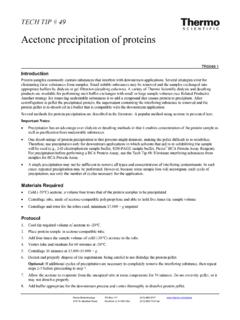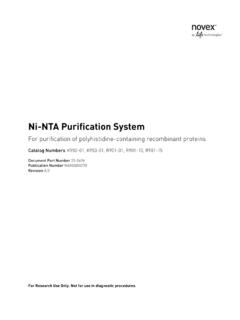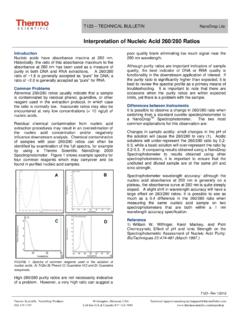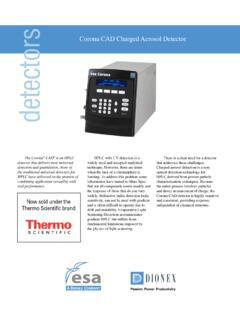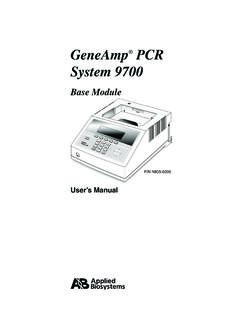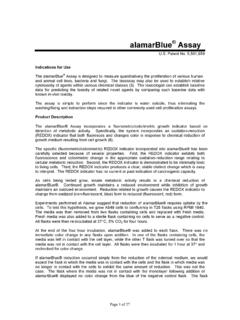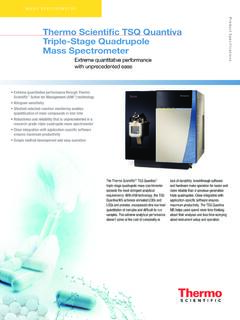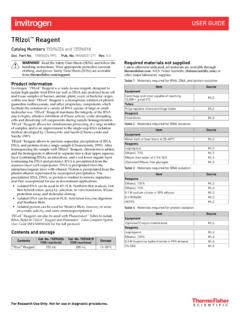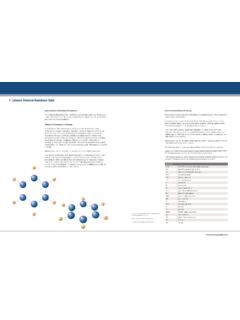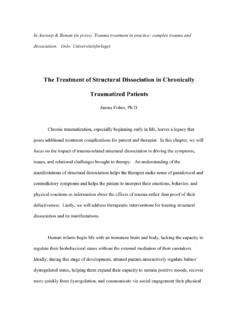Transcription of TR0006.4 Introduction - Thermo Fisher Scientific
1 TECH TIP #6 Pierce Biotechnology PO Box 117 (815) 968-0747 3747 N. Meridian Road Rockford, lL 61105 USA (815) 968-7316 fax Introduction In many applications involving peptides or proteins it is important either to identify fractions containing protein or to estimate the concentration of a purified sample. Amino acids containing aromatic side chains ( , tyrosine, tryptophan and phenyl-alanine) exhibit strong UV-light absorption. Consequently, proteins and peptides absorb UV-light in proportion to their aromatic amino acid content and total concentration. Once an absorptivity coefficient has been established for a given protein (with its fixed amino acid composition), the protein s concentration in solution can be calculated from its absorbance.
2 For most proteins, UV-light absorption allows detection of concentration down to 100 g/mL. Nevertheless, estimation of protein concentration by UV-light absorption is not accurate for complex protein solutions ( , cell lysates) because the composition of proteins with different absorption coefficients is not known. In addition, proteins are not the only molecules that absorb UV-light, and complex solutions will usually contain compounds like nucleic acids that interfere with protein concentration determination by this method. However, for aqueous protein solutions commonly used in the research laboratory setting, interference from other compounds is minimized by measuring absorbances at 280nm. Only the amino acids tryptophan (Trp, W) and tyrosine (Tyr, Y) and to a lesser extent cysteine (Cys, C) contribute significantly to peptide or protein absorbance at 280nm.
3 Phenylalanine (Phe, F), which was mentioned above, absorbs only at lower wavelengths (240-265nm). Absorbance and Extinction Coefficients The ratio of radiant power transmitted (P) by a sample to the radiant power incident (P0) on the sample is called the transmittance, T: T = P/P0 Absorbance (A), then, is defined as the logarithm (base 10) of the reciprocal of the transmittance: A = -log T = log (1/T) In a spectrophotometer, monochromatic plane-parallel light enters a sample at right angles to the plane-surface of the sample. In these conditions, the transmittance and absorbance of a sample depends on the molar concentration (c), light path length in centimeters (L), and molar absorptivity ( ) for the dissolved substance at the specified wavelength ( ).
4 1 T = 10 cL or A = c L Beer s Law states that molar absorptivity is constant (and the absorbance is proportional to concentration) for a given substance dissolved in a given solute and measured at a given For this reason, molar absorptivities are called molar absorption coefficients or molar extinction coefficients. Because transmittance and absorbance are unitless, the units for molar absorptivity must cancel with units of measure in concentration and light path. Therefore, molar absorptivities have units of M-1 cm-1. Standard laboratory spectrophotometers are fitted for use with 1cm-width sample cuvettes; hence, the path length is generally assumed to be equal to one and the term is dropped altogether in most calculations.
5 A = c L = c when L = 1cm The molar absorption coefficient of a peptide or protein is related to its tryptophan (W), tyrosine (Y) and cysteine (C) amino acid composition. At 280nm, this value is approximated by the weighted sum of the 280nm molar absorption coefficients of these three constituent amino acids, as described in the following equation:3,4 )125C()1490Y()5500W( + + =nnn where n is the number of each residue and the stated values are the amino acid molar absorptivities at 280nm. Extinction Coefficients A guide to understanding extinction coefficients, with emphasis on spectrophotometric determination of protein concentration Pierce Biotechnology PO Box 117 (815) 968-0747 3747 N. Meridian Road Rockford, lL 61105 USA (815) 968-7316 fax 2 Determining the Protein Concentration of a Solution from its Absorbance Solving the expression of Beer s law for concentration, one can easily see what values are needed to determine the concentration of a peptide or protein solution: c = A / L ( = A / when L = 1 cm) Dividing the measured absorbance of a peptide or protein solution by the calculated or known molar extinction coefficient yields the molar concentration of the peptide or protein solution.
6 The peptide or protein amino acid composition must be known to calculate the molar extinction coefficient using the formula stated in the previous section. A brief reading of the cited articles3,4 makes one appreciate that there is no single correct extinction coefficient value for a complex molecule like a peptide or protein. Even minor differences in buffer type, ionic strength and pH affects absorptivity values at least slightly. Most protein preparations, even those of equal purity, differ slightly in conformation and extent of modifications, such as oxidation, and these also affect absorptivity. Therefore, the best extinction coefficient value is one that is determined empirically using a solution of the study protein of known concentration dissolved in the same buffer as the sample ( , see discussion of Pierce Albumin Standards to follow).
7 Alternatively, absorption coefficients ( , extinction coefficients) for many proteins have been compiled from the literature and reported in the Practical Handbook of Biochemistry and Molecular These values provide sufficient accuracy for most routine laboratory applications that require an assessment of protein concentration. Most sources report extinction coefficients for proteins measured at or near a wavelength of 280nm in phosphate or other physiologic buffer. Molar Extinction Coefficients vs. Absorbances for 1% Solutions Application of a molar extinction coefficient in the calculation yields an expression of concentration in terms of molarity: A / molar = molar concentration However, many sources, including the reference cited above, do not provide molar extinction coefficients.
8 Instead, they provide absorbance (A280nm) values for 1% (= 1g/100mL) solutions measured in a 1 cm cuvette. These values can be understood as percent solution extinction coefficients ( percent) having units of (g/100mL)-1 cm-1 instead of M-1cm-1. Consequently, when these values are applied as extinction coefficients in the general formula, the units for concentration, c, are percent solution ( , 1% = 1g/100mL = 10mg/mL). A / percent = percent concentration If one wishes to report concentration in terms of mg/ml, then an adjustment factor of 10 must be made when using these percent solution extinction coefficients ( , one must convert from 10 mg/ml units to 1 mg/ml concentration units). (A / percent) 10 = concentration in mg/ml The relationship between molar extinction coefficient ( molar) and percent extinction coefficient ( percent) is as follows: ( molar) 10 = ( percent) (molecular weight of protein) Still other sources provide protein absorbance values for (= mg/mL) solutions, as this unit of measure is more convenient and common for protein work than percent solution.
9 This variation in reporting style underscores the importance of carefully reading stated values to be sure that the unit of measure is understood and applied correctly. Examples A. Proteins and Protein Mixtures with Unknown Extinction Coefficients If no extinction coefficient information exists for a protein or protein mixture of interest, and a rough estimate of protein concentration is required for a solution that has no other interfering substances, assume percent = 10. Most protein extinction coefficients ( percent) range from to Therefore, although any given protein can vary significantly from percent = 10, the average for a mixture of many different proteins likely will be approximately 10. B. Immunoglobulins Most mammalian antibodies ( , immunoglobulins) have protein extinction coefficients ( percent) in the range of 12 to 15.
10 Therefore, for typical antibody solutions, assume 14A%1nm280= or 1nm 280% For a typical IgG with MW = 150,000, this value corresponds to a molar extinction coefficient ( ) equal to 210,000M-1 cm-1. Pierce Biotechnology PO Box 117 (815) 968-0747 3747 N. Meridian Road Rockford, lL 61105 USA (815) 968-7316 fax 3 C. Bovine Serum Albumin (BSA) Thermo Scientific Pierce Albumin Standard Ampules (Product No. 23209) are provided as 2mg/mL solutions of purified bovine serum albumin (BSA) in NaCl. The product is calibrated by direct comparison of the absorbance at 280nm to a known concentration of a BSA standard from the National Institute of Standards and Technology (NIST). Numerous values for the absorptivity of BSA have been reported in the literature but are generally ~ for a 1% solution at 280nm.
